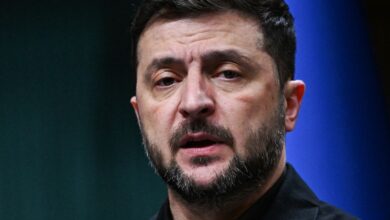
“I feel very optimistic that we can get something done here, because we made a tremendous amount of progress,” the US Secretary of State, Marco Rubio, told me at a late-night news conference at the US Mission in the Swiss city.
Even President Donald Trump, who just hours earlier had again publicly scolded the Ukrainian leadership for expressing what he regarded as insufficient gratitude, was now “quite pleased at the reports we’ve given him about the amount of progress that’s been made,” Rubio added.
But the Secretary of State, who unexpectedly appeared in the briefing room alone, instead of being accompanied, as he had been earlier that day, by the powerful head of the Ukrainian delegation, Andriy Yermak, repeatedly refused to be drawn on the specifics of what had been achieved.
“I’m not going to get into the details of the topics we discussed, because this is an ongoing process,” Rubio told me, while suggesting in other comments that “the items that remain are not insurmountable.”
But given the extent of the deep compromises Ukraine is being called on to make in the publicly available version of the US peace proposals – which are seen as heavily favoring Russia – the suggestion that they can be easily overcome rings hollow.
The proposal for Ukraine to surrender key territories in the Donbas region of Eastern Ukraine, for example, that Russia has annexed but not captured, has been a longstanding red line for Kyiv, not least because the area includes the “fortress belt” of heavily defended towns and cities seen as essential to Ukrainian security.
The US proposals seen by CNN suggest the area becomes a Russian demilitarized zone, which the Kremlin’s military forces would agree not to enter. But ordering the Ukrainian military to hand over land that its troops have fought and died to keep would be a hard sell.

Same too, the proposed limitation on Ukraine’s armed forces. Although set at a maximum of 600,000-strong in the US plan, European officials say they fear it would leave the country vulnerable to future attack.
But Washington, seemingly even more determined to force through a peace deal, has made it clear it expects Ukraine to comply, threatening to withdraw US military support for Kyiv and allow the Ukrainian President Volodymyr Zelensky – in the words of President Trump – “to fight his little heart out.”
In a statement on Sunday night from Washington, the White House said that the Ukrainians believe the latest draft of the peace proposals “reflects their national security interests,” after various revisions and clarifications made with input from top US, Ukrainian and European officials in Geneva.
“The Ukrainian delegation affirmed that all of their principal concerns – security guarantees, long-term economic development, infrastructure protection, freedom of navigation, and political sovereignty – were thoroughly addressed during the meeting,” the statement said.
Even if the current draft US peace proposal does indeed now work for Ukraine, it is very possible that it would no longer work for Russia, which has consistently refused to back down from its maximalist demands.
And the Kremlin has so far faced limited US pressure to do so.
In Geneva, Secretary of State Rubio repeatedly side-stepped my attempts to ask him whether the US would also expect Russia, not just Ukraine, to make any significant concessions.
But if the White House is actually serious about achieving what it now calls “a durable, comprehensive peace” in Ukraine, somehow convincing the Kremlin to compromise may be its best bet.




